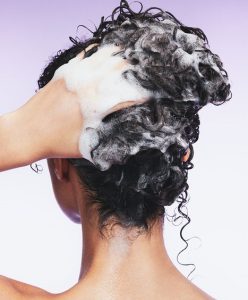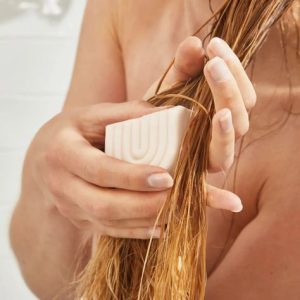Hair conditioner is an essential part of any hair care routine. They help replenish moisture, detangle strands, and boost manageability. But did you know there’s a whole category of protein conditioner formulated specifically to address certain hair concerns? Enter protein conditioners!
Protein conditioners are packed with protein molecules that can help strengthen and repair hair. This article dives deep into the world of protein conditioners, exploring their benefits, how they work, and whether they’re right for your hair type.
What is Protein and Why is it Important for Hair?
Hair is made up of keratin, a protein that gives hair its structure and strength. Over time, exposure to heat styling, coloring treatments, and environmental factors can damage keratin, leading to weak, brittle strands.
Protein conditioners contain protein molecules that can bind to the hair shaft. These molecules help fill in damaged gaps in the hair’s cuticle, the outermost layer. This can strengthen hair, improve elasticity, and add shine.

Benefits of Protein Conditioners
Here are some of the key benefits of using protein conditioners:
- Strengthen hair: Protein conditioners can help repair and strengthen weak, damaged hair.
- Reduce breakage: By improving hair strength, protein conditioners can help reduce breakage caused by brushing, styling, and environmental factors.
- Improve manageability: Protein can help smooth the hair cuticle, making hair smoother and easier to manage.
- Add shine: Healthy, strong hair reflects light better, resulting in shinier locks.
- Thicken hair: Protein conditioners can temporarily plump up hair strands, creating the appearance of thicker hair.
If you’re dealing with weak, damaged, or limp hair, a protein conditioner might be a good addition to your hair care routine.

How Do Protein Conditioners Work?
Protein conditioners work in two main ways:
-
Binding to hair: The protein molecules in the conditioner adhere to the hair shaft, particularly to damaged areas. This helps fill in gaps in the hair cuticle and smooth the hair’s surface.
-
Strengthening: As the protein molecules bind to the hair, they can help strengthen the hair’s structure and improve its elasticity. This makes hair more resistant to breakage.
It’s important to note that protein conditioners work best on the surface of the hair. They don’t penetrate deep into the hair shaft. However, the benefits they provide can significantly improve the look and feel of your hair.
Are Protein Conditioners Right for Your Hair Type?
Protein conditioners can be beneficial for most hair types, but they can be especially helpful for:
- Damaged hair: If your hair is weak, brittle, or prone to breakage, a protein conditioner can help repair and strengthen it.
- Color-treated hair: Color treatments can damage hair, so a protein conditioner can help replenish lost protein and improve hair health.
- Coarse hair: Coarse hair can be prone to frizz and tangles. Protein conditioners can help smooth the hair cuticle and improve manageability.
However, if you have very fine hair, using too much protein can make it feel heavy or straw-like. In this case, use a protein conditioner sparingly or opt for a lightweight formula.
Here’s a quick guide to help you decide:
- Fine hair: Use protein conditioners occasionally or in diluted form.
- Normal hair: Use protein conditioners regularly as part of your hair care routine.
- Thick hair: Use protein conditioners regularly.

How to Use Protein Conditioners
To get the most out of your protein conditioner, follow these steps:
Shampoo your hair:
Start with a clarifying shampoo to remove any buildup from styling products or previous conditioners.
Apply the conditioner:
Apply the protein conditioner to the mid-lengths and ends of your hair, avoiding the roots.
- Let it sit: Leave the conditioner on your hair for 3-5 minutes to allow the protein to absorb.
- Rinse thoroughly: Rinse the conditioner out completely with cool water. Cool water helps seal the hair cuticle.
- Use a light conditioner: If your hair feels heavy after using a protein conditioner, follow up with a lightweight conditioner to add moisture.
You can use a protein conditioner once or twice a week, depending on your hair’s needs.

Protein conditioners offer a targeted approach to hair care. By replenishing protein and strengthening hair, they can help improve the overall health and appearance of your locks. Consider incorporating a protein conditioner into your routine if your hair is weak, damaged, or needs a boost of strength and shine. Experiment and find what works best for your hair type and texture!
Alternatives to Protein Conditioners
While protein conditioners offer a wealth of benefits, they may not be for everyone. Here are some alternatives to consider:
-
Moisturizing conditioners: If your hair is dry or brittle but not necessarily weak, a moisturizing conditioner might be a better choice. Moisturizing conditioners focus on hydrating hair strands and improving softness.
-
Deep conditioners: Deep conditioners are intensive treatments that penetrate the hair shaft to deliver deep hydration and nourishment. They can be a good option for all hair types, especially if your hair is very dry or damaged.
-
Leave-in conditioners: Leave-in conditioners provide lightweight hydration and manageability throughout the day. They can be a good option for all hair types, including those that tend to get weighed down by traditional conditioners.
-
Natural hair masks: Hair masks made with natural ingredients like avocado, banana, or honey can provide deep conditioning and nourishment for your hair. These are a great option for people who prefer all-natural hair care products.
Consulting with a hairstylist can help you determine the best type of conditioner for your hair type and needs.

DIY Protein Treatments at Home
For those who are interested in a more natural approach, there are some DIY protein treatments you can try at home. Here are a few options:
-
Egg mask: Eggs are a natural source of protein. To make an egg mask, whisk together an egg with a tablespoon of olive oil and apply it to your hair. Leave it on for 20 minutes and then rinse thoroughly.
-
Gelatin treatment: Gelatin is another source of protein. To make a gelatin treatment, mix one tablespoon of gelatin with a cup of warm water. Let the mixture cool slightly and then apply it to your hair. Leave it on for 30 minutes and then rinse thoroughly.
-
Yogurt mask: Yogurt contains protein and lactic acid, which can help improve hair health. To make a yogurt mask, mix plain yogurt with a tablespoon of honey and apply it to your hair. Leave it on for 20 minutes and then rinse thoroughly.
Important note: Before trying any new hair treatment, it’s a good idea to do a patch test on a small area of your skin to check for any allergic reactions.

Leave a Reply